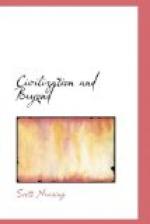The changes that took place in the summer of 1914 involved an almost complete reversal of purpose and direction. Up to that point Europeans were devoting a considerable proportion of their time to production and the maintenance of the normal life routine. At that point they left their homes, exchanged ordinary clothes for uniforms, laid down the implements of peace, picked up the weapons of war and prepared, under very expert leadership and direction, a series of mass movements designed to disrupt the ordinary life routine of other human beings on the other side of lines drawn on a map, but having little relation to customary life activity and even less to geography.
Execution of this purpose involved a mass movement from the home territory into that occupied by the “enemy”. If the enemy resisted he must be forced to do the will of the invaders. Instead of cooperating in a joint effort to maintain and improve the general welfare, uniformed, armed, expertly-led masses began beating up each other, until one side gave in and cried “enough.”
Plans for war had been drawn and redrawn for years, for decades. Elaborate preparations had been made. Destructive weapons had been designed and built. Transport had been provided, food stored. Defensive preparations had also been made in the form of fortifications so placed as to obstruct or prevent “the enemy” from crossing the “frontier”.
When sport-lovers go from home for a day to play a competition in another city or province, they go, play the game and then go back home to continue the ordinary life routine. In the case of the project we are now considering they left home in July, 1914 and returned months or years later. Many never got back home because they were killed in battle or died of wounds; many were “missing”; they disappeared.
If casualties in the 1914-18 war had been numbered in dozens, or scores or even in hundreds, the communities from which they came could have gone on without them—handicapped perhaps but not seriously disrupted. But when they were numbered in thousands and tens of thousands it was a quite different story. Actually, they were numbered in millions.
Mobilized to carry on the war were 42.2 million on the Allied side. On the side of the Central Powers, 22.8 millions. The total: 65 million. 12 million of those mobilized were Russian, 11 million were Germans, 8.4 million were French, 8 million were from the British Empire. From Austro-Hungary came 7.8 million, from Italy, 5.6 million. Turkey furnished 2.9 million, Bulgaria 1.2 million; 4.4 million came from the United States; 0.8 million from Japan. Lesser numbers came from other countries.
Except for Spain, the largest contributions of war conscripts came from the countries with the largest populations. With the exception of Spain, all of the great powers of Europe provided the “cannon fodder”; the human beings which Europe’s “great powers” assembled to take part in this profligate orgy of mass murder which went on for more than four years, from July 1914 until November 1918.




